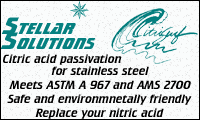
-----
Passivating a nickel-plated part
Quickstart:
Stainless steel will usually encounter plain steel somewhere during its manufacturing process, and the presence of even microscopic amounts of iron can cause rusting and pitting of stainless steel.
Therefore stainless steel is usually 'passivated' at the end of the manufacturing process. This involves immersion in nitric acid or citric acid to dissolve any iron from the surface.
Specs for the passivation process include:
• AMS 2700 for aerospace
• ASTM F86 for implants
• ASTM A967 for everything else
![]()
this text gets replaced with bannerText

Q. I have a part that is nickel plated stainless steel. Customer is asking for the part to be modified, which will remove the nickel plating from the area we are machining. If we send the part out to passivate the newly machined surface, will the passivation process damage the nickel plating on the rest of the part?
Trevor FallsEngineer - Carson City, Nevada
August 26, 2025
A. Hi Trevor. This could indeed be problematic. Nitric acid will dissolve the nickel plating. Citric acid will have less effect, and if the solution is not aerated and exposure is limited, I suspect it will be alright ... although additional opinions or experiences are certainly welcome.
Luck & Regards,

Ted Mooney, P.E. RET
Striving to live Aloha
finishing.com - Pine Beach, New Jersey
Ted is available for instant help
or longer-term assistance.
A. Trevor,
I concur with Ted. Citric acid is much less risky here. Some people with nickel alloy parts even "passivate" in citric to remove suspected iron contamination.
Citric is pretty easy handling too, you should be able to do it in-house if you like.
adv.
Let me know if my company can assist you with this.

Ray Kremer
Stellar Solutions, Inc.
McHenry, Illinois

Q, A, or Comment on THIS thread -or- Start a NEW Thread